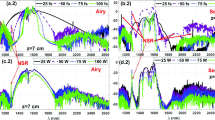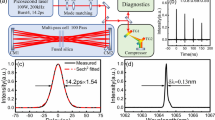Abstract
The amplification of super-Gaussian pulses in a system of bit rate 40 Gb/s with duty cycle 0.5 by traveling-wave semiconductor optical amplifier (TW-SOA) is investigated. The carrier wavelength of the super-Gaussian pulse is 1550 nm. Simulative results related to pulse broadening due to nonlinear self-phase modulation (SPM) phenomenon are analyzed and compared. This paper analyses the issues of super-Gaussian pulse and spectrum distortion in semiconductor optical amplifiers (SOA). It is shown that the amplified super-Gaussian pulse shapes and their spectra are depended on the length of SOA and compared the results with the published work.
Access provided by CONRICYT-eBooks. Download conference paper PDF
Similar content being viewed by others
Keywords
1 Introduction
Semiconductor optical amplifiers (SOA) are very important candidate in high-speed optical communication systems [1,2,3]. The amplifiers can amplify ultra-short optical pulses of the order of picoseconds [4, 5] as they possess very large bandwidth (~few THz). In any amplifier, nonlinearities due to gain saturation leading to pulse distortion because the leading edge of the pulse saturates the amplifier which reduces the gain available for the trailing edge of the pulse [6, 7]. Under different operating conditions, both pulse compression and pulse broadening can be obtained in the saturation region but no such cases arise if pulse energy is a small fraction of the saturation energy and hence the input pulse can be amplified without significant distortion. Sometimes pulse shape may remain unchanged but spectrum can be distorted considerably which is particularly important where the changes in the carrier density occurring as a result of gain saturation and leading to large change in refractive index [8].
The spectrum shift depends on input pulse energy and the amplifier gain among other things. The physical mechanism responsible for such shift is self-phase modulation (SPM) occurring as a result of nonlinear refractive index variation induced by gain saturation. Some investigations on pulse compression [9], wavelength conversion [10], and Gaussian pulse broadening [11] by SOA have made by us. This paper, in continuation of earlier works, analyses the issues of super-Gaussian pulse and spectrum distortion in SOA.
2 Basic Equations
The material gain coefficient g per unit length depends on initial carrier density (Ni) and carrier density at transparency (N0) [9] and is given as,
where differential gain is \( \sigma_{\text{g}} \). Therefore, net gain coefficient per unit length will be,
where optical confinement factor is \( \Gamma \), and loss is \( \sigma_{\text{s}} \) in per unit length of SOA. G0 is the amplification factor when length is L, and therefore, \( G_{0} = {\text{e}}^{{g_{T} L}} \). Using Eqs. (1) and (2)
The carrier lifetime (tc) depends on the physical parameters of SOA, namely surface and defect recombination coefficient (A), radiative recombination coefficient (B), Auger recombination coefficient (C), and initial carrier density (Ni) [10], and given as,
3 Simulation Layout
4 Results and Discussions
Calculated value of carrier lifetime (tc) is 1.4 ns, bit period (Tb) is 25 ps, TFWHM is 12.5 ps, and T0 is 7.5 ps. Figure 2 shows the initial super-Gaussian pulse shape and spectra of 5, 50, and 100 mW. Figure 3 shows the shape of the amplified pulses at amplification factor of 29 dB.
Amplified super-Gaussian pulses of Fig. 2
In Fig. 3, the spectra of the pulses with multipeak structure and with well-expressed right shift are shown. The new spectrum and the amount of the right shift strongly depend on the initial pulse shape.
Now, the amplified super-Gaussian pulse (for same pulse and SOA parameters as above) changes as a function from the length of the TW-SOA.
The values of the Length of the TW-SOA are set as 0.0002, 0.0003, 0.0005 m.
Figure 4 reveals that the length factor of the TW-SOA influences the pulse shape and spectrum. For a fixed input power of 50 mW, optical confinement factor of 0.3 and zero internal losses with variable lengths (L) of 0.0002, 0.0003 m, 0.0005 leads to an increase of power of amplified super-Gaussian pulse and the more the amplification factor G0 increases, it increases the right shift also. The spectrum develops a multipeaks. The dominant peaks right shifted means it shifts toward longer wavelengths. Amplification factor \(G_{0} = {\text{e}}^{{(\Gamma \sigma_{g} (N_{\text{i}} - N_{0} ) - \sigma_{s} )L}}\) and therefore increase of length leads an increase of amplification factor G0.
In Table 2, we can see that the amplified pulse gain will increase by increasing the length of TW-SOA [8].
5 Conclusion
The amplification of super-Gaussian pulses by semiconductor optical amplifier shows pulse broadening due to SPM phenomenon. SPM induced gain saturation and hence carrier density variation in the gain medium is the basis for such broadening. Simulative results show the pulse broadening and multipeak spectra along with the amplification of the pulse. Results also show how frequency is right shifted (so-called red shift) which is useful in group velocity dispersion compensation in optical fibers. The study can be extended for chirped pulses as well.
References
M. J. O’Maony, “Semiconductor laser amplifiers for use in future fiber systems”, J. Lightwave Technol., Vol. 6, pp. 531–544, 1988.
N. A. Olsson, “Lightwave systems with optical amplifiers”, J. Lightwave Tecgnol., Vol. 7, pp. 1071–1092, 1989.
I. W. Marshall, D. M. Spirit and M. J. O’Mahony, “Picosecond pulse response of a traveling-wave semiconductor laser amplifier”, Electron. Lett., Vol. 23, pp. 818–819, 1987.
G. Eisenstein, P. B. Hansen, J. M. Wiesenfeld R. S. Tucker and G. Raybon, “Amplification of high repetition rate picosecond pulses using an InGaAsP traveling-wave optical amplifier”, Appl. Phys. Lett., Vol. 53, pp. 1539–1541, 1988.
N. J. Frigo, “Ultrashort pulse propagation in suitable media: A simple physical model”, IEEE J. Quantum Electron., Vol. QE-19, pp. 511–519, 1983.
A. E. siegman, Lasers, Mill Valley, CA: University Science, 1986, Ch. 10.
G. P. Agarwal, “Self-phase modulation and spectral broadening of optical pulses in semiconductor laser amplifiers”, IEEE J. Quantum Electron., Vol. 25, No. 11, pp. 2297–2306, 1989.
A. Abd El Aziz, W. P. Ng, Z. Ghassemlooy, Moustafa H. Aly, Member, and M. F. Chiang, “Optimization of the Key SOA Parameters for Amplification and Switching”, ISBN: 978-1-902560-19-9.
M. Rahim and Md. A. Sekh, “Pulse Compression using Semiconductor Optical Amplifier”, pg. 441–446, Conf. Proc. ICMCTI 2017, UIT, Burdwan University, India, 23-25 March, 2017, Excel India Publishers, Page No 441–446, ISBN 9789386256607
M. Rahim and Md. A. Sekh, “FWM Based Wavelength Conversion Using Semiconductor Optical Amplifier (SOA)”, International Journal of Industrial Electronics and Electrical Engineering, ISSN: 2347-6982 Volume-4, Issue-10, Oct.-2016. IJIEEE-IRAJ-DOI-6020.
M. Rahim and Md. A. Sekh, “Pulse Broadening in Semiconductor Optical Amplifier,” in 13th International Conference on Fiber Optics and Photonics, OSA Technical Digest (https://doi.org/10.1364/PHOTONICS.2016.W3A.36) (Optical Society of America, 2016), paper W3A.36.
Author information
Authors and Affiliations
Corresponding author
Editor information
Editors and Affiliations
Rights and permissions
Copyright information
© 2018 Springer Nature Singapore Pte Ltd.
About this paper
Cite this paper
Rahim, M., Asraful Sekh, M. (2018). Investigation of Super-Gaussian Pulse Amplification in Semiconductor Optical Amplifier (SOA). In: Bera, R., Sarkar, S., Chakraborty, S. (eds) Advances in Communication, Devices and Networking. Lecture Notes in Electrical Engineering, vol 462. Springer, Singapore. https://doi.org/10.1007/978-981-10-7901-6_4
Download citation
DOI: https://doi.org/10.1007/978-981-10-7901-6_4
Published:
Publisher Name: Springer, Singapore
Print ISBN: 978-981-10-7900-9
Online ISBN: 978-981-10-7901-6
eBook Packages: EngineeringEngineering (R0)








